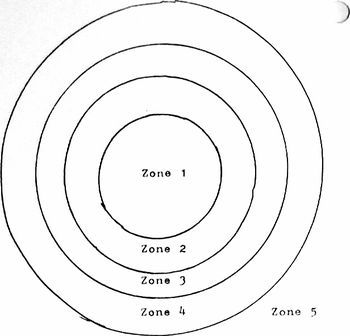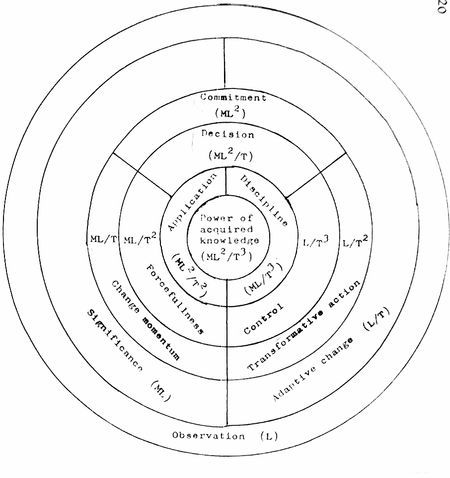It is convenient to designate as a "domain" that subset of the space of psycho-social communication within which questions of a particular type maintain their credibility for sufficient time to sustain a discourse. If Attali's lead is to be pursued, the nature of such domains needs to be clarified.
Attali argues that three theories open the way to an analysis of the production and circulation of meaning in an organization (5, pp. 207-208). The theories converge and give the following. An organization exists:
- when information having significance for its members is circulating and produces a compromise between identity and diversity (cf. Henri Atlan (17))
- when the production of the organization by itself obeys non-linear, continuous laws (cf. Prigogine (1 8))
- when the dynamic laws of a form can be elucidated from the discontinuities in its processes (cf. Rene Thorn (19)).
| Diagram 4a: Schematic relationship of learning zones associated with a particular answer domain |
 |
| Zone 1: No significant new information acquired from beyond domain. The domain engenders answers perceived as comprehensive and self-consistent. Supporters are totally committed.
Zone 2: Learning rate with respect to domain (zone 1) is greater than rate of generation of new meaning from other domains. The significance of the domain is increasing. Supporters become progressively more convinced.
Zone 3: Learning rate with respect to domain is less than rate of generation of new meaning from other domains. The significance of other domains is increasing. Supporters are attracted by other domains.
Zone 4: Learning rate with respect to domain (zone 1) is undermined and eroded by learning rate with respect to other domains. The relative significance of the domain is decreasing.
Zone 5: Existence of the domain is not recognized. |
| Diagram 4b: Possible ("standing wave") articulation of an answer domain in terms of number of learning factors |
 |
| Based on Table 2 and Diagram 5, but organized to correspond to Diagram 4a Note that the more frequently occurring or short-lived the answer domain, the fewer the number of learning factors characteristic of its organization. Thus the most frequent domains would only have zone "L", namely with one factor only Few answer domains would develop to the stage of including six factors, namely zone "ML2/T3" |
The form may be destroyed by aggression, noise, fluctuation, catastrophe, or by the accumulation of internal conflicts. Attali argues that under the first two forms of truth, any such crisis can only be overcome by absorbing or eliminating the disturbance.
In order to link the argument more closely to human and social development, it is appropriate to express the organization of such domains of significance in terms of the learning process (as in Diagram 4).
A domain of this type clearly remains fairly stable provided it can extract or "import" information (products) on which the learning process can feed. Knowledge, in the form of processed information, is then distributed out from the centre of the domain, or "exported" beyond its periphery, as part of the process maintaining the stability of the domain.
Before discussing the nature of this "learning" process in more detail, it is appropriate to note that it involves the accumulation of knowledge in one form or another. Domains based on the accumulation of knowledge, in its narrow sense, are not the only kinds of domain characteristic of society. Similar domains arise from other accumulation processes which each create a coherent environment for communication or exchange. At this stage it is therefore useful to make the argument more concrete by giving an extensive range of examples of accumulation which each tend to give rise to such domains (see Table 1).
| Table 1: Transformative interrelationships of complementary forms of accelerative - including accumulation of human need satisfiers (tentative) | |||||||||
| . | Infinition Context | Health | Understanding | Maintenance | Movement | Opinion/Relief | Government | Industry | Human-Nature |
| Qualitative | Responsibility | Love (family, | Objective | Quality of living | Authenticity | Subjective | Initiative | Inventiveness | Equanimity (Justice) (Detachment) |
| Beta- | Logic-defining | Personal | Philosophical | Creativity | Self/command | Altruism | Liberation | Appropriateness | Human |
| Beta- | Goal-defining | Policy-making | Linguistic cap. | Design cap. | Unified system | Absolving cap. | Aid | Atipropriatenes | Enhancement |
| Alpha- | Honouring cap. | Personal | Interpretive | Culture | Strategic cap. | Defining cap.: | Power, influence | Agricultural improvement | Order |
| Alpha- | Investigating | Organizing capacity | Information | Habitable env. | Process control | Reputation | Capital | Industrial | Environment |
| Social-II | Normative cap. | Recuperative | Know/how | Recreation | Military cap: | Celebratory cap. | Legislative cap. | Food | Laws |
| Social-I | Family bonds Dynastic bonds | Relationships | Information | Maintenance cap. | Mobility, trav. | Informing cap, | Goods | Artefact | Precautions |
| Biological | Plants (and microflora) | Invertebrates (and microfauna) | Vertebrates (reptiles, fish) | Humans | Appreciation of nature | ||||
| Physical | Breathable fresh air | Drinkable fresh water | Warmth (or ooolth) Interaction.with sun/fire | Earth for agriculture (land) | Appreciation of physical environment | ||||
| Existential fundamentals | Time-related existence | Space related existance | |||||||